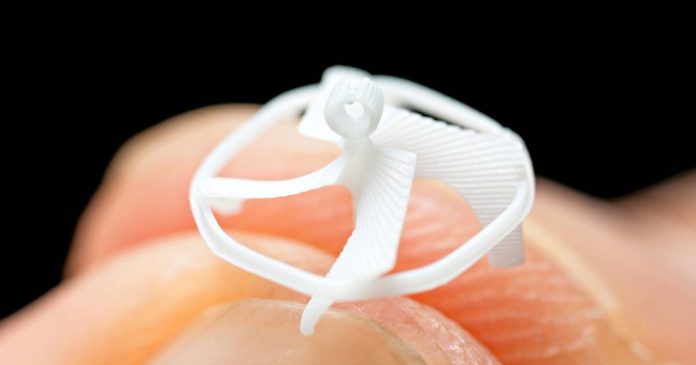Scientists have created what they say is the world’s smallest untethered flying robot, by taking a unique approach to its design. To minimize size and weight, they’ve moved the bot’s power and control systems out of its sub-centimeter-wide body.
Measuring just 9.4 mm in width and tipping the scales at 21 mg, the robot is being developed by Prof. Liwei Lin and colleagues at the University of California, Berkeley.
It mimics the flight capabilities of the bumblebee. Like that insect, it can hover in place, move both vertically and horizontally, and hit small targets. Its descendants could one day perform tasks such as pollinating crops, or exploring spaces too small for ordinary drones to access.
The bot’s 3D-printed polymer body consists of a four-bladed horizontal propeller, encircled by a “balance ring.” Protruding up from the center of the propeller is a small vertical ring that holds two puck-shaped neodymium permanent magnets – each one is 1 mm wide by 0.5 mm thick.
Adam Lau/Berkeley Engineering
The robot is powered and steered by an alternating magnetic field which is externally generated along a single axis.
As the bot’s two magnets are simultaneously attracted to and repelled by that field, they cause the attached propeller to spin, creating lift. Once the robot has become airborne, its balance ring adds rotational inertia, producing a stability-boosting gyroscopic effect.
Uniformly increasing or decreasing the strength of the magnetic field moves the robot up or down by causing it to spin faster or slower, respectively. And by varying the magnetic field’s strength over horizontal distance, it’s possible to move the bot forward, backward, or sideways accordingly.

Adam Lau/Berkeley Engineering
The scientists now plan on adding sensors that will allow the robot to maintain steady flight by self-correcting for variables such as wind gusts. They also hope to make the device even smaller, thus reducing its energy requirements by utilizing a weaker magnetic field.
A paper on the research was recently published in the journal Science Advances.
Source: UC Berkeley






